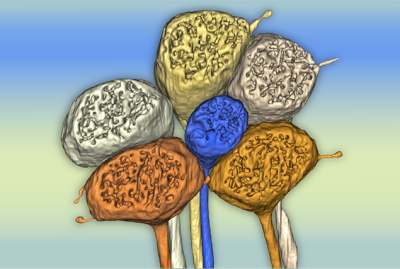
Bulb-like axon terminals of cone photoreceptors in the marmoset’s foveal retina. The blue pedicle, a short wavelength sensitive neuron, gives rise to complex circuitry that starts a neural code for color perception. Image credit: Yeon Jin Kim, University of Washington.
New findings in color vision research imply that humans can perceive a greater range of blue tones than monkeys do.
University of Washington scientists compared connections between color-transmitting nerve cells in the retinas of humans with those in two monkeys, the Old World macaque and the New World common marmoset. The ancestors of modern humans diverged from these two other primate species approximately 25 million years ago.
By using a fine scale microscopic reconstruction method, the researchers wanted to determine if the neural wiring of the areas associated with color vision is conserved across these three species, despite each taking their own independent evolutionary pathways.
The researchers discovered that a certain short-wave or blue sensitive cone circuit found in humans is absent in marmosets. It is also different from the circuit seen in the macaque monkey. Other features the scientists found in the nerve cell connections in human color vision were not expected, based on earlier nonhuman primate color vision models.